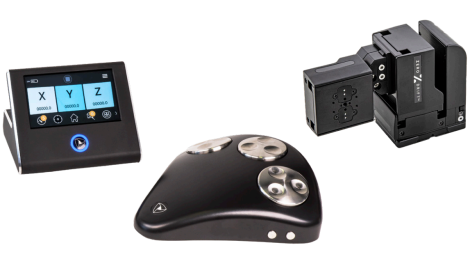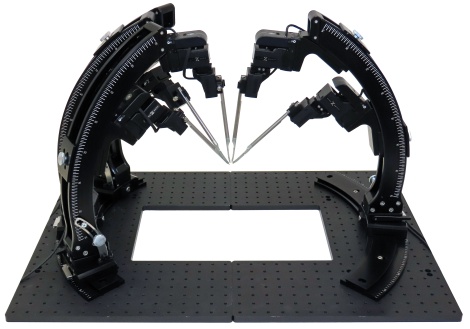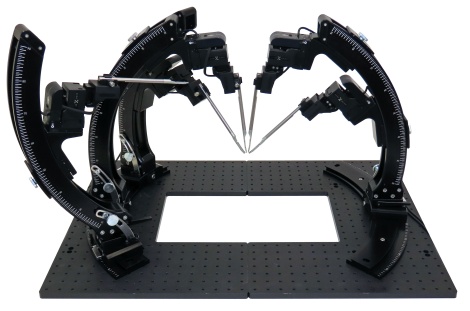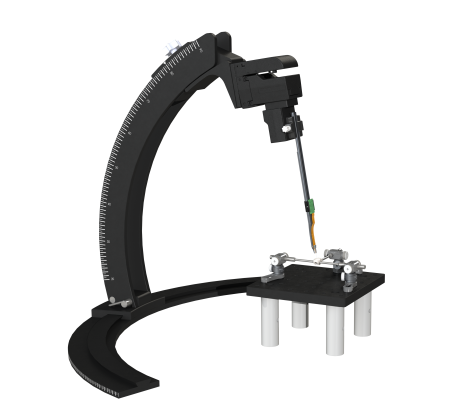A multiprobe rig made for in vivo recordings
Our modular multiprobe rig is designed with demanding experiments in mind. No matter if you are using Neuropixels, Neuronexus, or other silicon probes for high-density extracellular recordings, if flexibility and reliability are key for your experiments, thanks to the proven Sensapex repeatability and stability, we have you covered.
The complete rig is designed around a spherical coordinate system to allow for easy targeting of structures even if they are deep in the brain. The literal basis of the rig are the 90 degree ring segments. Up to four of these tracks can be used to form the azimuth coordinate base. On this base, the arms providing the elevation adjustment are attached. A specifically adapted version of our three-axis uMp-3 manipulators can be fixed to the desired elevation angle. In contrast to similar multiprobe rigs, it is possible to mount multiple manipulators on a single arm, allowing multiple independent probes to be positioned at the same azimuth.
Why choose the multiprobe rig for your recordings?
- Clearly readable angle scales make angle adjustment in elevation and azimuth easy and reproducible – for up to dozens of probes.
- Reliable planning and insertion of multiple probes thanks to full support in the Pinpoint software suite, including brain atlas support.
- Full control over insertion speeds, down to 1 um/s for the best possible recording quality
- The ability to mount up to three individually controlled probes at the same azimuth angles enables unprecedented recording density.
- With the most accurate electrophysiology manipulator on the market used for final positioning and insertion ensures all probes end up exactly where they need to be. Every time.
How does the multiprobe rig make experiments easier?
Reliable set up
There is no question about it: some of the multiprobe rig components look chunky – this is because the entire rig is designed to be extremely sturdy. There is no sagging or winding of the arms, even if three manipulators are installed on it. The knurled thumbscrews ensure that once adjusted, both azimuth and altitude angles are fixed and stay fixed. The probe holders reproducibly slot into the manipulators at a fixed spin angle and position, to ensure reproducible positioning all the way down to the probe.
Legible settings
The high contrast angle scales make it very easy to read the position of each manipulator in azimuth and elevation, even in a poorly lit environment. Combined with the large radii of the arms and ring segments, this allows angles to be set with an error of less than 1 degree (roughly the reproducibility limit resulting from variability between animals). Should more accuracy be required, the elevation angle can be read out through to 0.1 degrees resolution through an accelerometer integrated into the manipulators.
Easy probe exchange
To reduce the risk of damage during probe exchange, the probe holders can easily be retracted, to pull the sensitive recording shank out of the cluster of other probes and the head fixation device. After that, the entire arm easily flips back to provide easy access for inserting or replacing the probe in the probe holder. Once ready, the arm flips towards the sample again, and the probe holder slides back into the registered position, returning the recording shank to where it needs to be.
Atlas integration for planning and insertion

Full control over probe insertion
The insertion itself, including the final positioning of the probe is achieved using a three-axis manipulator (uMp-3-NP) with the proven accuracy and reliability of Sensapex manipulators. The movement range is 20 mm on all axes, with a resolution of 5 nm. The movement speed can be controlled by hand, using the rotary wheel controllers, or preset to allow a steady smooth motion. Speeds can be as slow as 1 micron per second, ensuring high quality recordings with a large number of units.
Overview of our multiprobe rig accessories
- The uMp-TSC touch screen unit provides an intuitive and stand-alone user interface that is used together with uMp-RW3 wheel controllers. In addition to basic operation with manipulator selection and speed setting, many unique features are offered like customizable wheel-to-axis and movement direction definitions, absolute vs. relative coordinate views, and 1-click smooth insertions with defined speeds and depth. All functions and configuration options for the full device range is provided by this small unit – no additional PC is required for setup and use.
- The uMp-3NP micromanipulators are a dedicated version of our standard three axis uMp-3 manipulator, adapted specifically for use with the multiprobe rig. In contrast to the standard three axis manipulator, the three axes are fixed to an orthogonal orientation, meaning that the angle of the approach axis cannot be changed (this is instead achieved through setting of the elevation angle on the arm).
- Standard accessories include manipulator bases with convenient mechanisms to aid pipette exchange, as well as versatile selection of adapters for attaching amplified head-stages and rod like items. In particular, we have full selection of Neuropixel probe holders available at our webstore (including the new 2.0 versions).
We facilitate new discoveries
Sensapex has had the privilege to provide products to more than 1000 labs worldwide. We are regularly surprised and impressed by the clever way in which our manipulators are used for experiments. Often in ways that we never imagined. Our ever-growing list of References showcases some of the amazing work being done with our instruments.
Sensapex products are proprietary and patented (US 9,138,892, US 9,662,783, EP 2 776 215, US 10,427,292; EP 09851052.2, EP15906190.2, US 15/765,608, EP: 15906189.4). Automated patch clamp (US 9,498,293 and US 9,668,804) and pipette cleaning (US 15/232,770 and EP 16836035.2) products are manufactured under licenses from GTRC and MIT, U.S.A.
uMp-RNG and uMp-ARM
- Stable and reproducible positioning of Neuropixel probes
- All angles, including “spin” of the probe can be adjusted
- Azimuth (φ) and altitude (θ) rotate centered on the brain
- Up to four manipulators per arm (i.e. per azimuth angle)
- Ring segments can be used individually or as a complete ring
- Flip-action allows easy access to all probes
- Space for mounting a floating ball or treadmill in the centre
- Theoretical maximum of 54 probes

uMp-3 NP micromanipulators
- The most stable manipulator for electrophysiology
- Smooth probe insertion at down to 1µm per second
- Probeholders for Neuropixels v1 and v2
- Plan and visualise insertion using PinPoint
- Full control of probe insertion – manual or automated
- Compact and intuitive touch screen display
- Rotary wheel with intuitive fingertip feeling


